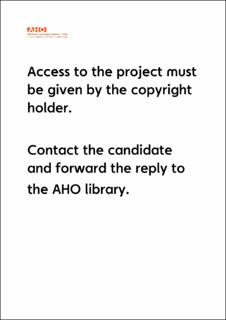| dc.description | Railways (NSB) as part of a much larger complex. After shutting down operaions a few years earlier, much of the facility was demolished in 1967. Today, the building is protected through the Planning and Building Act (Plan- og bygningsloven) on the municipal level, and is situated in a development area with high activity. Its immediate surrounding were made into a park already in the year 2000, after the municipality acquired the building with the site in 1997.
The building has been vacant for a number of years, and its condition has deteriorated greatly during this time. In the autumn of 2023, the Municipality of Oslo, which owns the building, started a process to decide what it should be used for. This process will be concluded in the spring of 2024.
---
For several decades, artists and artists unions have described a critical situation with regards to access to working spaces and studios for artists in the city. Not only is this a challenge for the individual artist and artists as a group – it is also problematic for the city, which has explicitly expressed the value of and need for vibrant and vitalistic artistic presence as a driving force for the city’s ambitions of being a city of culture.
During 2023, the debate about access to artist studios was reignited when Oslo municipality announced that the contracts for 150 of the artists working in the city’s 330 subsidized studios would not be renewed in 2024. This came about due to the municipality’s new plans for two of its largest temporary studio sites; Myntgata and Ila Pensjonat. In practise, this represents a 45% reduction of municipal studios. The rise of this debate inspired the response in this diploma project. Artist unions such as the Norwegian Visual Artists (NBK), Young Artists’ Society (UKS) and Visual Artists Oslo (BO) warn that as a result of the restrictive private market in tandem with the lack of proactivity – and even regression – on the part of the municipality forces artists to leave the city in order to find spaces to work and live.
The majority of Oslo’s 1150 visual artists do not rent a studio through the municipal studio program. On the private market, the studio situation has also become increasingly difficult, with risiing prices and a shortage of suitable spaces available for rent. Furthermore, it is exactly the areas which have been developed into the new cultural districts in the city that used to be prime locations for artists to find spaces to work, in the old industrial, logistics and production zones along the shore fronts. Where there used to be artist studios and underground galleries we today instead find the premier national institutions for the arts; The Munch Museum, the Oslo Opera House, the National Museum of the Arts, The Deichman Library, The Astrup Fearnley Museum, and so on.
For the Locomotive Workshop, I have attempted to imagine a way for the city to invite the production side of the art community back into the Fjord city, by establishing a hub for the diverse and broad range of output which it maintains. From crucial studio spaces, where the individual artist develops and produces artworks, exhibitions and public art, to artist-run and artist-led exhibition spaces where the profession’s research and development is put on display. Also present are workshops for specialized areas such as wood, plaster- and metal-work, where artists from the whole city may rent time for production. Further, office space and smaller scale studios make it possible to establish working environments for curators and critics, and larger office spaces on the ground floor may be suited for businesses connected to the art world, such as Oslo Art Guide or Atelie.art, an app where artists can sell their art online. In sum, the idea is to try to generate an open, bustling and vibrant scene which can offer the city another way to view art, from the maker’s perspective, as a compliment to the robust institutional art experiences on offer in the city today.
---
Historically, the Locomotive Workshop was a site for production, and the building is a pragmatic structure. The perimeter of loadbearing outer walls (as well as sections of outer walls that have been kept as the complex expanded), together with an array of columns, carry the large eaved roofs with monitor rooflights running along the gables. It consists of large, open spaces with great ceiling height and lots of daylight.
The principle idea for the project was to generate a stage for a substantial number of artists to work, and to build an infrastructure around them with workshops, project spaces and exhibition venues. But I was also interested in cultivating a community where professional discourse and collegiality is given space to arise.
Architecturally, I have attempted to let my project – and especially the studios located in the two main halls of the building – grow within the building without erasing it. I have tried to do this by operating with independent, secondary structures which are disconnected from the existing structures, to allow the old and new to co-exist and be experienced together. The language is on the one hand heavy and industrial, with large steel columns and beams carrying robust CLT floors. On the other hand, it is soft and pragmatic, with the actual studios constructed with light framing and plywood sheets.
Further, I have tried to offset the stringent and rhythmical structure of the original building with a more chaotic layout, which would hopefully work towards generating possibilities in the common spaces to meet, and work, and eat and exhibit and adjust how the space is used from day to day. | en_US |


